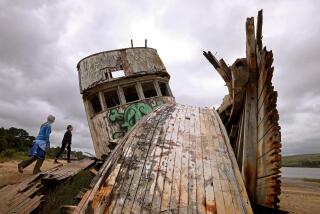Tourists witness a good turn for a baby tern
Tour boat captain Dan Salas radioed for help Saturday as soon as he noticed a drowning baby seabird in the rolling swell beside a barge anchored in Long Beach Harbor.
Three minutes later, Long Beach lifeguards arrived in a patrol boat and set to work, providing the 20 tourists aboard Salas’ 80-foot vessel, Kristina, with a rare view of an avian rescue operation half a mile offshore.
The passengers applauded and whistled when lifeguard John Virack carefully scooped the baby Caspian tern out of the water with two hands, then wrapped it in a towel for transport to a local bird rescue center.
Back on the barge, a raucous colony of Caspian terns had transformed mounds of coiled rope into shady camouflage for pale yellow hatchlings. Adult terns swooped in every few minutes with tiny silver fish in their beaks and promptly fed newly hatched birds. Others chased intruding brown pelicans, double-crested cormorants and Heermann’s gulls away from their nests on the flat deck.
The steel barge, a former icebreaker named Arctic Challenger, has become a precarious artificial nesting site for an estimated 350 Caspian terns -- slim, gull-like seabirds protected by the federal Migratory Bird Treaty Act.
The barge’s owner, Sause Bros. of Coos Bay, Ore., has agreed not to move it until all of the birds have matured and migrated elsewhere for the winter. Nonetheless, uncertainty shrouds the colony in the heart of the nation’s busiest port complex -- an area plied by freighters, harbor cruise ships, recreational boaters and roaring jet skiers.
“The fact that these birds have settled on this barge underlines a critical problem: We need more natural habitat for them,” said Susan Kaveggia, a biologist with the International Bird Rescue Research Center in San Pedro. “Terns need flat, barren, sandy or pebbly land on which to nest. There’s none left in the port complex, so they’re moving in desperation from boat to boat to boat.”
A year ago, more than 400 Caspian and elegant terns -- most too young to fly -- plummeted off two privately owned barges anchored not far from the Arctic Challenger. A few hours later, local beaches were littered with baby tern carcasses.
Three men were charged with animal cruelty in that case, which triggered one of the longest investigations ever by the California Department of Fish and Game.
Seven misdemeanor counts each were filed against tugboat operator Ralph Botticelli, 39, of San Diego, and two crewmen. Botticelli told The Times in February that his workers were attempting to move the barges from the port complex to Santa Barbara when they accidentally spooked the birds into stampeding off the sides.
Many of the terns now colonizing the Arctic Challenger are believed to have been former annual visitors to the barges involved in Botticelli’s case, which is pending.
Sause Bros. had been intending to move the Arctic Challenger within the next few weeks to its shipyard in Oregon for work. However, “we will leave the barge in place for as long as is necessary to protect the colony of Caspian terns through to maturity,” the company said in a written statement.
But Salas said Fish and Game officials were unaware of the colony until he alerted them a few days ago, worrying environmentalists who had been depending on the agency to avoid a repeat of last year’s catastrophe.
The situation has sparked an emotional debate among scientists on the best way to deal with the terns when they return next year.
Kathy Molina, a research associate at the Natural History Museum of Los Angeles County, has been pressing for the creation of protected sites onshore.
“These birds need the semblance of an island that allows them to come and go and maintain a family unit so they can be fed on time, and protected from the sun and predators,” Molina said. “Right now, there is no way for a chick that has fallen off to get back on the barge and into its territory where its parents can feed it and guard it.”
Garry George, executive director of the Los Angeles Audubon Society, said he thought a floating home could work.
“The best choice may be to designate certain barges as nesting areas, given that their natural habitat is all gone,” he said. “We’re already investigating the possibility of buying a barge and outfitting it with guardrails of some sort so that fledglings can’t walk off.
“But it hasn’t been easy,” he added. “Barges are hard to find, and expensive. Even if we get one, who’ll accept legal liability for it?”
Kaveggia, of the bird research center, and fellow biologist Cindie Kam had a more immediate problem Saturday: saving the life of the rescued baby tern.
“This poor little guy is shivering like a marathon swimmer,” Kaveggia said while drying its feathers with a towel.
“It’s about 2 to 3 weeks old, judging from the length of the feathers on its neck. The fact that it’s breathing through its mouth and has its eyes closed indicates it’s very stressed,” she said.
“If it survives, we’ll put a federal identification band on one of its legs and then turn it loose. But the big question is this: What are we going to do when its extended family returns next year?”
--
More to Read
Sign up for The Wild
We’ll help you find the best places to hike, bike and run, as well as the perfect silent spots for meditation and yoga.
You may occasionally receive promotional content from the Los Angeles Times.







